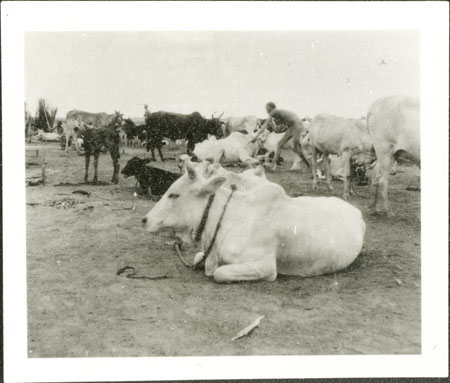Nuer ox with trained horn

40 x 30 mm | Print 35mm contact
There are records relating to alternative images that we do not have scans for in the database:
1998.346.210.1 - Negative film nitrate , (40 x 30 mm)
1998.346.210.1 - Negative film nitrate , (40 x 30 mm)
Date of Print:
Unknown
Previous PRM Number:
EP.N.210
Previous Other Number:
2
Accession Number:
1998.346.210.2
Description:
A white ox with a leather cord tether lying on the ground with other cattle nearby.
Its left horn has been trained to grow across the muzzle (ma gut) by making a cut on the horn against which it will grow.
This training is mirrored in the male practice of binding the left arm with metal bands called thiau, both of which are often done soon after initiation.
Photographer:
Edward Evan Evans-Pritchard
Date of Photo:
1930 - 1936
Region:
[Southern Sudan] Upper Nile or Jonglei
Group:
Nuer Lou
PRM Source:
Edward Evan Evans-Pritchard
Acquired:
Donated 1966
Other Owners:
E. E. Evans-Pritchard Collection
Class:
Settlement , Animal Husbandry
Keyword:
Animal Cattle , Cattle Camp
Documentation:
Original catalogue lists in Manuscript Collections. Additional material in related documents files. [CM 27/9/2005]
Primary Documentation:
Accession Book Entry: [p.
98] 1966.27 [1 - 24] G[ift] PROFESSOR E.
E.
EVANS-PRITCHARD; INST.
OF SOCIAL ANTHROPOLOGY, 51 BANBURY RD.
OXFORD 1966.27.17 S.
SUDAN.
NUER TRIBE.
Box of negatives each in separate envelope, labelled.
(some missing).
Nos.
1 - 213.
(prints in box 1966.27.18)...1966.27.18 S.
SUDAN.
NUER TRIBE.
Box of prints each in separate envelope.
Nos.
1 - 213.
(negatives in 1966.27.17.)
Manual Catalogues [typewritten, entitled "Nuer Photographs (E-P)"] - 210. Cattle ( magud ox). (S.) [Small size]
Note on print reverse ms pencil - "2 210"
Manual Catalogues [typewritten, entitled "Nuer Photographs (E-P)"] - 210. Cattle ( magud ox). (S.) [Small size]
Note on print reverse ms pencil - "2 210"
Other Information:
In Nuer Religion (Oxford University Press 1974 [1957] 256), E.
E.
Evans-Pritchard notes that 'It is remarkable also that Nuer compare to the initiation of youths the cutting (ngat) of the horns of favourite oxen (they are entire animals at the time) so that they will grow against the cut at fancy angles, generally in a curve across the muzzle (ma gut).
[Chris Morton 21/4/2004]
Recorder:
Christopher Morton [21/4/2004] [Southern Sudan Project]

